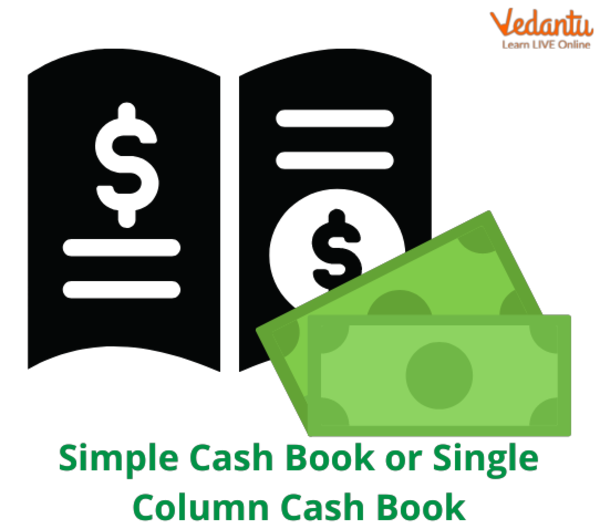




What is the Single-Column Cash Book?
Cash transactions are recorded in just one column of the cash book. It's essentially the same thing as a checking account. Every credit and debit side of the cash book format just contains a single amount line. Cash inflows are recorded in the debit column, while outflows are accounted for in the credit column. The single-column cash book is designed to make it simple for businesses to keep track of their cash flows over a certain period. Moreover, a cash book means you figure out how much money you have left over after the fiscal year.

Single-Column Cash Book
A cash book with just one column represents nothing more than an account for cash. Because you can't "pay with what you don't have," a cash book cannot display a credit status. That's why it's never normal for a cash account to be positive.
Cash Book Format in Detail
The cash book will show the owner the actual state of the company's cash flow. The debit entries are on the left side of a 'T' shaped currency book, while the credits are on the right.
The cash inflows are represented by the "debit" column and the "cash outflows" column. Every cash inflow is recorded on the cash book's receipt side, and every cash outflow is documented on the cash book's payment side.
The balance is calculated by subtracting the amount received from the amount paid out after the day or period. This figure represents a company's available cash on hand. The cash book is a record of all monetary transactions.
The following cash book example elaborates on each section of the one-column cash account; here is the single-column cash book format:
Date: - It keeps track of the day, month, and year a deal was made (receipts and payments). It is unnecessary to provide the month and year for every transaction if they all occurred within the same calendar and month.
Explanation: - If money is collected, the account's identity goes on the debit column. So if money is given, the account's name goes on the credit column. Cash holdings for a specific time are recorded first, then transactions for that period are reported.
Defining Cash Book

What does Cash Book records?
To keep track of all of your financial dealings, big and small, cash or check, you should keep a cash book. It is possible to keep track of financial transactions in a cash book, which serves as a diary and a ledger.
Cash transactions, including purchases, payments, and credit sales, are recorded in a cash book. The payment date, client name (if applicable), and account that will be debited (minus amount) or credited (plus amount) will all be shown (minus amount). The remaining balance is recorded as "cash" in the accounting ledger when the day is through.
The cash book records all transactions involving cash. Cash in the bank, in the till, sales tax, etc. Income is kept in the simple cash book in both a notebook and a ledger. Cash outflows and inflows are recorded, making it a "double-entry" bookkeeping record. In accounting, debits signify value increases or account for assets, whereas credits signify losses in value or records for liabilities.
Things to Know for Posting Cash Book Entries

Posting entries in a Cash Account
A cash book is not the same as one cash account. Cash operations are maintained in a cash book, a specialised ledger, rather than a cash account that is part of the general ledger.
When it comes to keeping track of money, a cash account is set up, resembling a ledger, while a cash book combines the functions of the two.
Every cash book transaction is recorded regularly to the applicable general ledger and subsidiary ledger accounts. What follows is a description of how to make a posting:
Cash book b/d and c/d (i.e. daily beginning and ending balances) are not reported.
A cash book's debit (or receipt) side transactions or entries are transferred to the ledger's credit (payment) side columns.
The debit sides of the corresponding ledger accounts are updated with the cash book's credit ground (or payout side) entries.
The posting source section of the single-column cash book contains the reference list of the ledger for which the transactions have been transferred. It's simple to look up a particular ledger account and see the updated balance.
DR CR
Advantages of Manual Cash Book Format
There are two cash columns in the manual cash book format style. The debits will be shown in one column and the credits in another. Each entry's first line specifies the date, applicable client names, and the account that will be debited or credited. At the bottom of each section is the final tally.
Keeping a cash book account format may benefit you in the listed ways:
To begin, most exchanges in almost all commercial enterprises are monetary. It would take an inordinate amount of time and effort to credit and debit the cash balance for every activity when a cash book was not kept, and money transfers were not noted in the journal.
As cash is readily taken by dishonest personnel, it is essential that the cash track is updated and adequately controlled by a responsible person. This leads to the second benefit. For this reason, keeping an accurate and organised cash book detailing all monetary exchanges is crucial.
Conclusion
All cash transactions for a given day at a business are recorded in a special ledger called the cash book, which is distinct from the cash account towards which entries are made within the journal. The cash account's balancing entries need not be sent to the general ledger. After making changes, the general ledger is updated.
In a nutshell, a cash book facilitates efficient cash management by allowing management to keep track of cash plus bank accounts and make choices based on this information.
FAQs on Single-Column Cash Book: Everything You Need to Know
1. What is the purpose of maintaining a single cash book?
Every cash transaction throughout an accounting cycle is documented in a cash book that functions as an auxiliary to the ledger accounts. A cash book's principal function is to facilitate the efficient management of cash by providing a convenient means of ascertaining current and historical cash balances for use in financial planning and reporting. Accessing financial data in a cash book is usually considerably quicker than tracking the cash via a ledger. Daily checks on the balance ensure that any discrepancies are caught immediately and that all transactions are correct and up-to-date.
2. Which two items make up a cash book?
All transactions involving cash are recorded in the cash book. Money in the bank, in the till, sales tax, etc. The cash book is often separated into two sections for larger businesses: the cash payments journal, which documents cash payments made, and the account receivable journal, which documents cash received by the company. Amounts paid to suppliers to lower accounts payable would be recorded in the cash disbursement record. In contrast, cash receipts will comprise transactions made by clients to settle pending invoices receivable or receipts.
3. Is there a distinction between a Cash Book and a Cash Account?
The cash book is not the same as the cash account. Cash operations are kept in a cash book, a specialised ledger, rather than a cash account that is part of the general ledger. When it comes to keeping track of money, a cash account is set up like a ledger, while a cash book combines the two functions. Although not a cash account, a cash book requires details or a narrative regarding the origin or usage of monies.





















